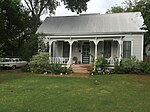Folk Victorian

Folk Victorian is an
Lost Creek Baltimore and Ohio Railroad Depot (1892), James B. Carden House (1885), Ephriam M. Baynard House, and Sibley's General Store (1899) in the Sibley's and James Store Historic District
.
Background
Some of the main features of the Folk Victorian style include: porches with spindlework detailing, an l-shape or a gable front plan, details or inspiration from the Italianate or Queen Anne style. It is often identified by basic or simpler details with asymmetrical floor plans.[1] The typical home is two-stories, with a single story porch.[4]
- Industrial Revolution
Many of these homes were put up during this time period due to the industrial revolution. [1]For those who were moving to the West needed simple and quick methods for building a house.[5] The easy access to all of the light weight lumber, helped to create a pre-cut and inexpensive way to get an iteration of the Victorian home.[5]
Gallery
-
The Orin Jordan House in Whittier, California is an example of a Folk Victorian
-
Early Folk Victorian home in Elgin, TX (Side Gable, Hall & Parlor design)
See also
References
- ^ OCLC 1350687620.
- ^ "Folk Victorian Houses, Photos, Styles, Architecture | Old House Web". www.oldhouseweb.com. Retrieved November 19, 2020.
- ^ 1870 - 1910: Folk Victorian Archived May 10, 2008, at the Wayback Machine; Vernacular Architecture From the Machine Age by Jackie Craven About.com
- ^ Historic Design Guidelines: Folk Victorian. Santa Barbara: City of Santa Barbara. pp. 1–4.
- ^ a b "Home". www.perintonhistoricalsociety.org. Retrieved November 20, 2022.


